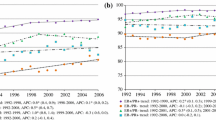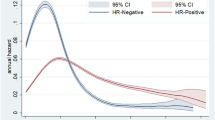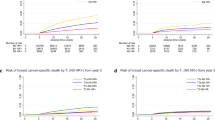Abstract
This study investigated the trends over time in age and stage specific population-based survival of estrogen receptor negative (ER−) breast cancer patients by examining the fraction of cured patients and the median survival time for uncured patients. Cause-specific survival data from the Surveillance, Epidemiology, and End Results program for cases diagnosed during 1992–1998 were used in mixed survival cure models to evaluate the cure fraction and the extension in survival for uncured patients. Survival trends were compared with adjuvant chemotherapy data available from an overlapping patterns-of-care study. For stage II N+ disease, the largest increase in cure fraction was 44–60% (P = 0.0257) for women aged ≥70 in contrast to a 7–8% point increase for women aged <50 or 50–69 (P = 0.056 and 0.038, respectively). For women with stage III disease, the increases in the cure fraction were not statistically significant, although women aged 50–69 had a 10% point increase (P = 0.103). Increases in cure fraction correspond with increases in the use of adjuvant chemotherapy, particularly for the oldest age group. In this article, for the first time, we estimate the cure fraction for ER− patients. We notice that at age ≥70, the accelerated increase in cure fraction from 1992 to 1998 for women with stage II N+ compared with stage III suggests a selective benefit for chemotherapy in the lower stage group.




Similar content being viewed by others
References
Early Breast Cancer Trialists’ Collaborative Group (EBCTCG), Clarke M, Coates AS, Darby SD et al (2008) Adjuvant chemotherapy in estrogen-poor breast cancer: patient-level meta-analysis of randomized trials. Lancet 371:29–40
Early Breast Cancer Trialists’ Collaborative Group (EBCTCG) (2005) Effects of chemotherapy and hormonal therapy for early breast cancer on recurrence and 15-year survival: an overview of the randomized trials. Lancet 365:1687–1717
Vogel VG, Costantino JP, Wickerham DL, National Surgical Adjuvant Breast, Bowel Project (NSABP) et al (2006) Effects of tamoxifen vs. raloxifene on the risk of developing invasive breast cancer and other disease outcomes: the NSABP? Study of Tamoxifen and Raloxifene (STAR) P-2 trial. JAMA 295:2727–2742
Edwards MJ, Gamel JW, Feuer EJ (1998) Improvement in the prognosis of breast cancer from 1965 to 1984. J Clin Oncol 16:1030–1035
Yu B, Tiwari RC, Cronin KA, Feuer EJ (2004) Cure fraction estimation from the mixture models for grouped survival data. Stat Med 23:1733–1747
Saphner T, Tormaey DC, Gray R (1996) Annual hazard rates of recurrence for breast cancer after primary therapy. J Clin Oncol 14:2738–2746
Hess KR, Pusztai L, Buzdar AU, Hortobagyi GN (2003) Estrogen receptors and distinct patterns of breast cancer relapse. Breast Cancer Res and Treat 78:105–118
Anderson WF, Chen BE, Jatoi I, Rosenberg PS (2006) Effects of estrogen receptor expression and histopathology on annual hazard rates of death from breast cancer. Breast Cancer Res Treat 100:121–126
Dignam JJ, Dukic V, Anderson SJ, Mamounas EP, Wickerham DL, Womark N (2009) Hazard of recurrence and adjuvant treatment effects over time in lymph node-negative breast cancer. Breast Cancer Res Treat 116:595–602
Klein JP, Moeschberger ML (1997) Survival analysis: techniques for censored and truncated data, 2nd edn. Springer, New York
Mariotto AB, Feuer EJ, Harlan LC, Abrams J (2006) Dissemination of adjuvant multiagent chemotherapy and tamoxifen for breast cancer in the United States using estrogen receptor information: 1975–1999. J Natl Cancer Inst Mongr 36:7–15
Yu B, Tiwari RC, Cronin KA, McDonald C, Feuer EJ (2005) CANSURV: a windows program for population-based cancer survival analysis. Comput Methods Programs Biomed 80(3):195–203
Akaike H (1974) A new look at the statistical model identification. IEEE Trans Automat Control 19(6):716–723
Huang L, Cronin K, Mariotto A, Feuer EJ (2008) Improved survival time: what can survival cure models tell us about population-based survival improvements in late stage colorectal, ovarian, and testicular cancer? Cancer 112(10):2289–2300
Yabroff KR, Lamont EB, Mariotto A, Warren JL, Topor M, Meekins A, Brown ML (2008) Cost of care for elderly cancer patients in the United States. J Natl Cancer Inst 100(9):630–641
Petrakis IE and Paraskakis S (2009) Breast cancer in elderly. Arch Gerontol Geriatr. doi:10.1016/j.archger.2009.03.007
Acknowledgments
The authors wish to thank the editors, and the referees for comments and suggestions. Work (JJD) was supported in part by a research grant from the Susan G. Komen for the Cure Foundation. The clinical trials data for Fig. 1 generation was obtained under Public Health Service grants NCI-U10-CA-69651 and NCI-U10-CA-12027 from the U.S. National Cancer Institute.
Author information
Authors and Affiliations
Corresponding author
Additional information
The study was conducted while the author was a contractor at National Cancer Institute (NCI), NIH, Bethesda, MD, USA.
Electronic supplementary material
Below is the link to the electronic supplementary material.
Rights and permissions
About this article
Cite this article
Huang, L., Johnson, K.A., Mariotto, A.B. et al. Population-based survival-cure analysis of ER-negative breast cancer. Breast Cancer Res Treat 123, 257–264 (2010). https://doi.org/10.1007/s10549-010-0752-z
Received:
Accepted:
Published:
Issue Date:
DOI: https://doi.org/10.1007/s10549-010-0752-z




